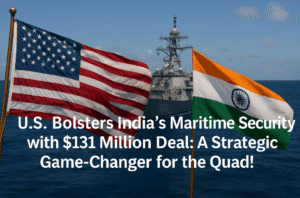U.S. Bolsters India’s Maritime Security with $131 Million Deal: A Strategic Game-Changer for the Quad!
The U.S. has greenlit a $131 million sale of advanced maritime surveillance technology to India, advancing the Quad’s Indo-Pacific Maritime Domain Awareness (IPMDA) initiative launched in 2022. The deal includes SeaVision software—enhanced for real-time ship tracking—and training to combat illegal fishing, piracy, and “dark shipping” in strategic waters. By integrating satellite data and analytics, India aims to strengthen monitoring of its coastline and exclusive economic zone, countering rising regional threats.
The sale underscores Quad progress in transforming security pledges into actionable tools, with U.S. firm Hawkeye 360 leading the contract. Notably, the absence of offset clauses signals India’s urgency to deploy capabilities swiftly amid China’s expanding naval presence. While technical integration is feasible, seamless Quad-wide data sharing remains a hurdle. The move reinforces U.S.-India defense ties and marks a critical step toward securing vital Indo-Pacific sea lanes, balancing collaboration with geopolitical pragmatism.

U.S. Bolsters India’s Maritime Security with $131 Million Deal: A Strategic Game-Changer for the Quad!
In a significant stride toward strengthening Indo-Pacific security collaboration, the U.S. has moved forward with a proposed $131 million sale of advanced maritime surveillance technology to India. The deal, notified to Congress on April 30, 2025, underscores the Quad alliance’s commitment to countering shared regional challenges through the Indo-Pacific Maritime Domain Awareness (IPMDA) initiative.
The IPMDA Initiative: A Quad Cornerstone
Announced at the 2022 Tokyo Quad Summit, IPMDA aims to combat illegal fishing, monitor “dark shipping” (vessels disabling tracking systems), and enhance real-time maritime surveillance across critical Indo-Pacific waterways. By integrating data from satellites, radars, and sensors, the initiative seeks to create a unified operational picture for partner nations, covering hotspots like the Indian Ocean Region (IOR), Southeast Asia, and the Pacific Islands. For India—a key Quad member flanked by strategic sea lanes—this technology is pivotal for safeguarding its 7,500 km coastline and countering threats like piracy, smuggling, and unauthorized incursions.
What’s in the Deal?
The proposed sale includes:
- SeaVision Software: A cutting-edge platform enabling maritime traffic analysis and anomaly detection, customized to India’s needs.
- Technical Training: U.S. personnel will provide hands-on support to optimize India’s use of the technology.
- Remote Analytics: Ongoing software updates and data analysis to maintain system efficacy.
Virginia-based Hawkeye 360, a leader in radio-frequency geospatial intelligence, will spearhead the contract. Notably, the deal lacks offset agreements, which typically mandate domestic investments by foreign contractors—a detail highlighting India’s urgency to deploy the tech swiftly.
Strategic Implications: Beyond Technology Transfer
- Countering China’s Influence: As China expands its naval footprint in the IOR, IPMDA equips India with enhanced surveillance to monitor adversarial activities and protect exclusive economic zones.
- Quad Credibility: This sale signals tangible progress for the Quad, often criticized for abstract pledges. Successful integration could spur similar collaborations among Australia, Japan, and Pacific Island nations.
- U.S.-India Defense Ties: Reinforces Washington’s recognition of India as a “major defense partner,” building on recent agreements like the Logistics Exchange Memorandum (LEMOA) and communications compatibility pacts.
Challenges and Next Steps
While the Indian Navy’s existing tech infrastructure should ease adoption, seamless data-sharing among Quad members remains a hurdle due to varying security protocols. Additionally, the initiative’s effectiveness hinges on expanding regional participation—a task requiring diplomatic finesse to avoid perceptions of exclusivity.
The Road Ahead
Following a pilot phase in select regions, IPMDA is poised for full-scale rollout. As Indian Navy Chief Adm. R. Hari Kumar emphasized, the system will be critical for “securing sea lines of communication,” vital for global trade. For the Quad, this deal is more than a transaction—it’s a litmus test for transforming vision into a rules-based Indo-Pacific order.
The urgency to bypass offset clauses reveals India’s strategic prioritization of rapid capability enhancement over domestic industrial gains—a calculated move amid rising regional tensions. Meanwhile, Hawkeye 360’s role cements the growing synergy between private tech firms and global security frameworks, reshaping modern defense ecosystems.
As geopolitical tides shift, this collaboration marks a milestone in blending technology and alliance-building to secure one of the world’s most contested maritime arenas.
You must be logged in to post a comment.